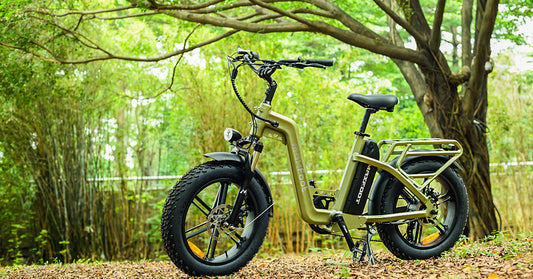Imagine you’re cruising down the New York City streets on a pleasant day, enjoying the fresh air and ease of your e-bike. Suddenly, the digital display blinks, signaling that your battery is on its last leg. As panic settles in, you might wonder, “What happens now?”
Still Rideable, But with a Catch. We want to reassure you that an e-bike doesn't become a huge paperweight once its battery drains completely. You can still pedal it to your destination just as you would a traditional bicycle. However, it's not going to be the same effortless ride you're accustomed to when its electric pedal assist was functioning.
Pedal-Assist E-Bikes: A Glimpse into Their Working Mechanism
To understand why, let's delve into the mechanics of a pedal-assist electric bike. These e-bikes use a system where the electric motor assists only when you pedal. This system consists of a battery, a drivetrain, and a sensor to detect pedaling action.
When the battery is charged, as you start pedaling, the sensor detects this motion and engages the electric motor, which supplements your pedaling efforts. The harder you pedal, the more assistance the system provides. This makes the ride smoother and less strenuous, especially on uphill climbs or long journeys.
Can You Ride an Electric Bike When Its Battery Dies?
The straightforward answer is Yes; you can ride an e-bike even when its battery dies. However, there are certain challenges you should be aware of.
Challenge 1: The Weight Factor
E-bikes are considerably heavier than their traditional counterparts due to the additional components like the battery and motor. An average e-bike can weigh anywhere between 40 to 80 pounds, almost twice the weight of a typical bicycle (weights around 18 to 28 lbs.).
Pedaling a bike this heavy without electric assistance is tedious, especially over long distances or uphill.
Challenge 2: Motor Resistance
Another challenge is the potential resistance from the motor. While most modern e-bikes are designed to minimize this factor, it can still be noticeable, especially in cheaper models. This resistance can make pedaling slightly harder than it would be on a regular bike.
What to Do If Your E-Bike Battery Dies?
Finding your e-bike battery depleted in the middle of a pleasant ride can be a frustrating experience. Here are a few options you can consider to manage such situations.
Option #1: Pedal to Your Destination
As mentioned earlier, your e-bike doesn't turn into an immovable object once the battery dies. It can still function as a regular bike, albeit with a bit more effort due to its increased weight and possible motor resistance.
Option #2: Call for a Pickup
If your destination is far away or involves steep inclines, you might want to consider calling a friend for a pickup.
Remember, most e-bikes are heavier than conventional bikes, and hauling them into a car can be challenging. So, make sure the vehicle can accommodate the weight and size of your e-bike.
Option #3: Public Transportation
Most local buses have the facility to carry e-bikes. So, if your city transport does have it, try pedaling to the nearest best station. This will be another convenient way to complete your journey, especially if you're in a city with a comprehensive public transport system.
E-Bike Battery Life: An Overview
The longevity of an e-bike's battery is dependent on several factors like the battery capacity, the level of assistance used, the terrain, and the rider's weight. Generally, e-bike batteries can last anywhere between 15 to 60 miles on a single charge.
However, as the battery ages, its ability to hold a charge diminishes, reducing the distance you can travel on a full battery. Overall, the batteries are designed to last 600 to 800 charge cycles. This means you will normally need to replace the battery after 3 to 5 years.
Tips for Prolonging the Life of E-Bikes
Several practices can help prolong the life of your e-bike and its battery.
Regular Charge Your Electric Bike
It's advisable to regularly charge your e-bike battery, even if it's not completely drained. Lithium-ion batteries, commonly used in e-bikes, have no 'memory effect,' so frequent charging won't decrease their lifespan.
Avoid Extreme Temperatures
Extreme cold or heat can damage your battery. Therefore, it's essential to store and charge your e-bike in a temperate environment.
Maintenance is the Key
Regularly maintaining your e-bike can not only extend the life of the mechanical components but also the battery. Ensure that your tires are inflated correctly, and the drivetrain is clean and well-lubricated. This reduces the amount of work the motor has to do, thus conserving battery power.
Make use of Smart Riding Features
Opt for a lower level of assistance when you're riding on flat terrain or downhill, and save the high levels for uphill climbs. This balanced approach can significantly increase your battery life.
Final Words
Although an e-bike is indeed rideable when the battery dies, the journey might be less comfortable due to the additional weight and possible motor resistance.
Regular maintenance and smart riding habits can extend the life of your e-bike and its battery, ensuring many pleasant, worry-free rides.




